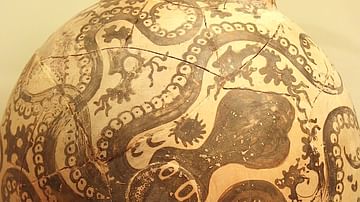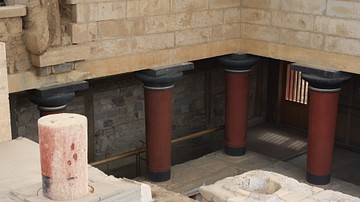
Egyptian Faience is a glassy substance manufactured expertly by the ancient Egyptians. The process was first developed in Mesopotamia, first at Ur and later at Babylon, with significant results but faience production reached its height of quality and quantity in Egypt. Some of the greatest faience-makers of antiquity were the Phoenicians of cities such as Tyre and Sidon who were so expert in making glass that it is thought they invented the process. The Egyptians took the Phoenician technique and improved upon it, creating works of art which still intrigue and fascinate people in the present day.
Faience was made by grinding quartz or sand crystals together with various amounts of sodium, potassium, calcium, magnesium, and copper oxide. The resulting substance was formed into whatever shape was desired, whether an amulet, beads, a broach or a figurine and then said pieces were heated. During heating, the pieces would harden and develop a bright color which was then finely glazed. It is thought that the Egyptian artisans perfected faience in an attempt to imitate turquoise and other hard to find gem stones. The calcium silicates in the mixture were responsible for the bright colors and the glassy finish.
Among the most famous of faience statuary is the blue hippopotamus popularly known as "William", currently on exhibit at the Metropolitan Museum of Art in Manhattan, NY, USA. This piece was one of a pair found in the shaft of the tomb of the steward Senbi II who served under either Senusret I (c. 1971-1926 BCE) or Senusret II (c. 1897-1878 BCE), both of the 12th Dynasty of the Middle Kingdom.
The figure was molded of faience and painted with river and marsh plants, representing the natural habitat of the hippo. A pasted of copper, limestone, and quartz oxide was then applied all over the figure which, when heated, turned it a bright blue. The hippo was considered an extremely dangerous animal by the ancient Egyptians and were sometimes included with grave goods (whether as statuary, amulet, or as an inscription) for protection of the deceased in the afterlife. The soul of the dead person, however, also required protection from its protecting hippo and some provision had to be made for this. In the case of "William" the Hippo, three of its legs were purposefully broken after the statue was completed so it would not be able to run after Senbi II in the afterlife and harm him.
Besides statuary, the Egyptians used faience for the manufacture of jewelry (rings, amulets, necklaces) but also for scarabs, to create the board and pieces for the game of Sennet, for furniture and even for bowls and cups. Among the most popular objects made from faience, however, were the Shabti dolls which were placed in the tombs of the dead. The Shabti was a figure, sometimes fashioned in the likeness of the deceased, who would take the dead person's place at communal work projects, ordained by the god Osiris, in the after-life of the Field of Reeds.
The poor of Egypt, if they could even afford a Shabti doll, would have one made of wood, while the more wealthy and the nobility commanded Shabti of faience. The colors of the faience (as with color generally) were thought to have special symbolism. Blue represented fertility, life, the Nile river on earth and in the after-life, green symbolized goodness and re-birth in the Field of Reeds, red was used for vitality and energy and also as protection from evil, black represented death and decay but also life and regeneration, and white symbolized purity. The colors one sees on the Shabti dolls, and in other faience, all have very specific meaning and combine to provide a protective energy for the object's owner.
The Egyptian word for faience was tjehenet which means 'gleaming' or 'shining' and the faience was thought to reflect the light of immortality. So closely was faience associated with the Egyptian after-life that the tiles for the chamber walls of tombs were made of faience as was seen at King Djoser's tomb at Saqqara and, most famously, in the tomb of Tutankhamum where over one hundred objects were entirely or partially of faience.

The earliest evidence of a faience workshop has been unearthed at Abydos and dated to 5500 BCE. The workshop consists of a number of circular pits, clearly the remains of kilns, with a lining of brick and all of them fire-marked. Layers of ancient ash in the pits are evidence of continuous use over many years. Small clay balls were also discovered and it is thought that they may have been used as the surface on which faience beads were fired in the kilns. The names of the faience makers are lost to history save for one man, Rekhamun, who was known as “Faience Maker of Amun”, and another known as Debeni, the overseer of faience workers. Of the other craftsmen in faience, and there must have been many, nothing is known.










